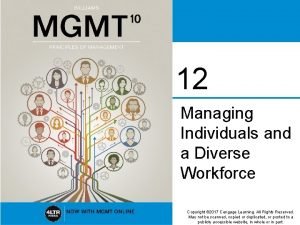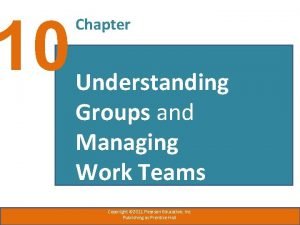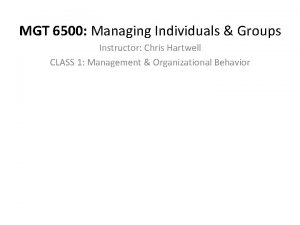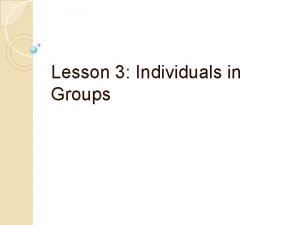MHR 6500 Managing Individuals Groups Instructor Chris Hartwell


















- Slides: 18

MHR 6500: Managing Individuals & Groups Instructor: Chris Hartwell Class 4: Motivation

• IKEA Case Analysis Announcements – Should have been handed in prior to class for full credit. – Can still be handed in with a 10% penalty for each 24 hours late (up to 72 hours) • Project Group Sign-ups – Should occur before midnight on Saturday • Next Class: Tuesday, Nov. 8 – EXAM 1

Objectives • Describe three major needs discussed in Mc. Clelland’s Need Theory. • Explain the practical significance of Herzberg’s distinction between motivators and hygiene factors. • Understand Adams’s Equity Theory of Motivation and the effect of perceived inequity in employee motivation. • Explain how organizational justice builds on equity theory, and compare three types of justice. • Understand the implications of Vroom’s Expectancy Theory • Understand the motivational mechanisms and practical implications regarding goal setting • Understand the process outlined in the job characteristics model


Mc. Clelland’s Need Theory • Behavior derives from a desire to satisfy inherent needs. • Three major needs: – Need for Achievement: A desire to accomplish, master, excel, and attain a high standard, and to be regarded highly by others. – Need for Affiliation: A desire to maintain positive social relationships, find emotional attachments with others, and avoid conflict. – Need for Power: A desire to influence and/or control others, and to lead others to achieve higher goals. • Socialized Power: Focus on accomplishing group goals and helping others succeed. • Personal Power: Seeking acquisition of personal stature, often at the expense of others.

Herzberg’s Motivator-Hygiene Theory • Motivators: Aspects of the job that are associated with job satisfaction (when high or present). – The content of the job • Hygiene Factors: Aspects of the job that are associated with job dissatisfaction (when low or absent). – The context of the job

Adam’s Equity Theory of Motivation • People strive for fairness and justice in social exchanges, interactions, and relationships. – Two components: • INPUTS: What the individual puts into the exchange/relationship • OUTPUTS: What the individual takes away from the exchange/relationship

Adam’s Equity Theory of Motivation • Consequences of Inequity: – Negative Inequity: Balance is restored by reducing inputs, increasing outputs, or changing perceptions. • This type of inequality results in the largest reactions – Positive Inequality: Balance is restored by increasing inputs, decreasing outputs, or changing perceptions. • Inequity or equity is all based on perceptions

Organizational Justice • Based out of equity theory, organizational justice refers to perceptions of fair treatment at work. • Three (four? ) types of organizational justice: – Distributive Justice: Perceived fairness in allocation of outcomes (resources, rewards, etc. ) – Procedural Justice: Perceived fairness in the processes/procedures used to make allocation decisions. – Interactional Justice: Perceived fairness of interactions when procedures are implemented. • Interpersonal Justice: Perceived fairness of social exchanges. • Informational Justice: Perceived fairness in the information exchanged.

Practical Lessons from Equity/Justice Theories 1. 2. 3. 4. 5. Pay attention to employees’ perceptions Allow employees to take part in decision-making Give the opportunity to appeal negative decisions Leaders should treat all employees equitably Employees’ perceptions are strongly influenced by the leadership behaviors exhibited by their managers. 6. Pay attention to the organization’s justice climate.

Vroom’s Expectancy Theory • People are motivated to behave in ways that produce valued outcomes. • Three perceptions in the formula: 1. Expectancy: effort performance • Self-esteem, self-efficacy, prior experience, support from others, information, resources 2. Instrumentality: performance outcome 3. Valence: value placed on the outcome

Vroom’s Expectancy Theory Effort Performance Outcome

Goal Setting • Identifying goals is an effective motivating technique. Why? • Four motivational mechanisms: 1. Directing Attention 2. Regulating Effort 3. Increasing Persistence 4. Foster Strategic Planning

Practical Implications for Goal Setting 1. Specific, high goals high performance 2. Feedback enhances the effect of #1 3. Self-set, assigned, and participative goals can all be effective. 4. Action planning facilitates goal accomplishment. 5. Goal commitment and monetary incentives affect outcomes.

Job Characteristics Model

Maintaining Motivation in Management Concern for Others’ Interests LOW HIGH LOW Apathetic Selfless: Self-sacrificing Givers HIGH Selfish: Takers Otherish: Successful Givers Concern for Self-interest

Benefits of being “Otherish” • • • Less burnout Greater sense of meaning Higher job satisfaction Higher career success Higher life satisfaction Success Giving

Final Notes • Groups will be finalized before next class • IKEA case grades and comments should be available next week • Next Class: Tuesday, Nov. 8 – EXAM 1
 Ifd 6500
Ifd 6500 Kolisch hartwell
Kolisch hartwell My ciena portal
My ciena portal Emerson csi 6500
Emerson csi 6500 Silicone logo
Silicone logo Toon blast 6500
Toon blast 6500 Spartanburg housing rental assistance
Spartanburg housing rental assistance Surface level diversity
Surface level diversity Photo/drawing of individuals/groups/institutions
Photo/drawing of individuals/groups/institutions The activities that independent individuals groups
The activities that independent individuals groups Understanding groups and teams
Understanding groups and teams Projet entrepreneurial bts mhr
Projet entrepreneurial bts mhr Sonic barrier mhr
Sonic barrier mhr What is maximum heart rate
What is maximum heart rate Erken deselerasyon
Erken deselerasyon Resting heart rate women
Resting heart rate women Anaerobic heart rate
Anaerobic heart rate Training area mhr
Training area mhr Mhr=220-16
Mhr=220-16



































